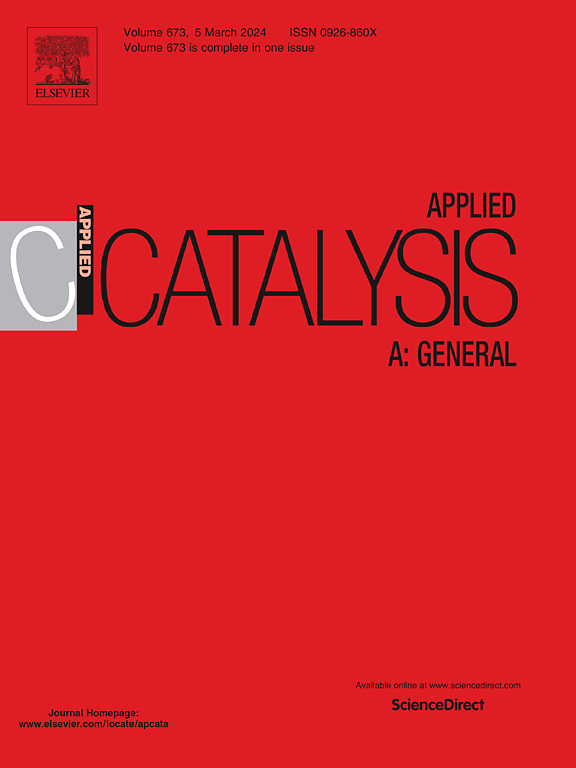Adsorption of Al2O3 {100} hydroxyl and Ni-Al2O3 electron transfer synergetic catalysis for efficient selective hydrogenation of unsaturated aldehydes
IF 4.7
2区 化学
Q2 CHEMISTRY, PHYSICAL
引用次数: 0
Abstract
The hydrogenation of the C![]() C bond in α-β unsaturated aldehydes faces substantial difficulties due to the steric hindrance and the conjugation effects of macromolecular unsaturated aldehydes. Herein, we introduce a novel approach to prepare nanosheet-structured Ni-Al2O3 catalysts featuring exposed {100} crystal planes and hydroxyl groups, utilizing a microfluidic system to easily control crystal plane growth achieve support modification. In-situ characterizations and DFT calculations reveal that the exposed {100} crystal plane, a strong metal-support interaction (SMSI) promotes electron transfer of Ni and significantly reducing the C
C bond in α-β unsaturated aldehydes faces substantial difficulties due to the steric hindrance and the conjugation effects of macromolecular unsaturated aldehydes. Herein, we introduce a novel approach to prepare nanosheet-structured Ni-Al2O3 catalysts featuring exposed {100} crystal planes and hydroxyl groups, utilizing a microfluidic system to easily control crystal plane growth achieve support modification. In-situ characterizations and DFT calculations reveal that the exposed {100} crystal plane, a strong metal-support interaction (SMSI) promotes electron transfer of Ni and significantly reducing the C![]() C hydrogenation energy barrier from 3.12 eV to 1.79 eV. The hydroxyl environment facilitates effective adsorption of the C
C hydrogenation energy barrier from 3.12 eV to 1.79 eV. The hydroxyl environment facilitates effective adsorption of the C![]() O bond, accelerating the reaction and enabling rapid desorption of the product. Under modified reaction conditions for the preparation of 2-ethylhexanol, the catalyst still achieved a yield of 99.9 %. This simple method of support modification enables rapid large-scale preparation, possessing significant potential for industrial applications.
O bond, accelerating the reaction and enabling rapid desorption of the product. Under modified reaction conditions for the preparation of 2-ethylhexanol, the catalyst still achieved a yield of 99.9 %. This simple method of support modification enables rapid large-scale preparation, possessing significant potential for industrial applications.
Al2O3{100}羟基吸附与Ni-Al2O3电子转移协同催化不饱和醛的高效选择性加氢
由于空间位阻和大分子不饱和醛的偶联作用,使α-β不饱和醛中CC键的加氢反应面临很大的困难。在此,我们介绍了一种新的方法来制备具有暴露的{100}晶面和羟基的纳米片结构Ni-Al2O3催化剂,利用微流控系统轻松控制晶面生长实现载体修饰。原位表征和DFT计算表明,暴露的{100}晶面,强金属-载体相互作用(SMSI)促进了Ni的电子转移,并显著降低了CC氢化能势,从3.12 eV降低到1.79 eV。羟基环境有利于CO键的有效吸附,加速反应,使产物快速脱附。在改进的反应条件下制备2-乙基己醇,催化剂的产率仍然达到99.9 %。这种简单的支持改性方法可以快速大规模制备,具有重要的工业应用潜力。
本文章由计算机程序翻译,如有差异,请以英文原文为准。
求助全文
约1分钟内获得全文
求助全文
来源期刊

Applied Catalysis A: General
化学-环境科学
CiteScore
9.00
自引率
5.50%
发文量
415
审稿时长
24 days
期刊介绍:
Applied Catalysis A: General publishes original papers on all aspects of catalysis of basic and practical interest to chemical scientists in both industrial and academic fields, with an emphasis onnew understanding of catalysts and catalytic reactions, new catalytic materials, new techniques, and new processes, especially those that have potential practical implications.
Papers that report results of a thorough study or optimization of systems or processes that are well understood, widely studied, or minor variations of known ones are discouraged. Authors should include statements in a separate section "Justification for Publication" of how the manuscript fits the scope of the journal in the cover letter to the editors. Submissions without such justification will be rejected without review.
 求助内容:
求助内容: 应助结果提醒方式:
应助结果提醒方式:


